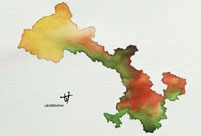 Africans in Guangzhou
Africans in Guangzhou
 Pole dancer shows strength and beauty up in the air
Pole dancer shows strength and beauty up in the air
 College girls call for protection of ecological space on earth
College girls call for protection of ecological space on earth
 Top 10 celebrities driving auto brands
Top 10 celebrities driving auto brands
 10 low-carbon tips to save money
10 low-carbon tips to save money
 Luxury cars make Asia premiere at Auto China
Luxury cars make Asia premiere at Auto China
 Versatile dog
Versatile dog
 Ni Ni covers BAZAAR JEWELRY
Ni Ni covers BAZAAR JEWELRY
 Cherry blossoms reach peak bloom in Washington D.C.
Cherry blossoms reach peak bloom in Washington D.C.
 Top Chinese fashion icons in foreigners' eyes
Top Chinese fashion icons in foreigners' eyes
CANBERRA, April 28 -- The new technology of towed side- sonar device will be deployed in four weeks, Angus Houston, chief coordinator of the Joint Agency Coordination Center (JACC) for the search of Malaysian Airline flight MH370, said here Monday.
At a press conference held in the Chinese Embassy in Australia, Houston said the towed side-sonar search would be conducted by possible private underwater search and recovery companies.
The device will work just above ocean floor, exactly as the Bluefin-21 Autonomous Underwater Vehicle does, to get maximum value from side-looking sonar.
"It had a wide cut than Bluefin. It travels along at quite a slow pace of about 4 to 6 knots. So it doesn't go very fast, but it's in the water all the time, providing a live image of the ocean floor all the time."
The only time it won't be able to do is when it turns the whole system around. It takes the device half a day to turn and change direction.
As was the case with visual search both by air and at sea, anything underwater will be de-conflicted so that there will be no conflict between one system or another.
"They will be coordinated so they will be separated," he said.
"In terms of how the ocean floor is covered, it will coordinate to do it in the most efficient and effective manner."
Houston said it's important to keep the continuity and momentum when the search has entered the new phase, during which four vessels from China, Malaysia and Australia will be involved and an Australian P-3 C Orion aircraft will be put in standby in timely response to any sighting by commercial or fishing vessels of possible debris.
 Hand-painted maps go viral online; painter's name remains unknown
Hand-painted maps go viral online; painter's name remains unknown 4th Beijing Int'l Film Festival ends
4th Beijing Int'l Film Festival ends Commando elite specializes in sign language
Commando elite specializes in sign language Man photoshops himself into girlfriend's childhood photos
Man photoshops himself into girlfriend's childhood photos Photo story: Stallholders at Beijing Zoo Wholesale Market
Photo story: Stallholders at Beijing Zoo Wholesale Market Artists on backstage
Artists on backstage Beckham launches fund to support youth soccer in China
Beckham launches fund to support youth soccer in China Cherry blossoms hit peak bloom in Washington D.C.
Cherry blossoms hit peak bloom in Washington D.C. Children in ancient costumes learn Zhusuan
Children in ancient costumes learn Zhusuan Cute Shaolin boy melts the hearts of millions
Cute Shaolin boy melts the hearts of millions Giant panda Sijia is back to happy life
Giant panda Sijia is back to happy life Richest Chinese of 2014: half from the mainland
Richest Chinese of 2014: half from the mainland Chengdu - laid-back lifestyle makes happiest city
Chengdu - laid-back lifestyle makes happiest city The backstage of the Fashion Week
The backstage of the Fashion Week College students in Han costumes
College students in Han costumesDay|Week|Month